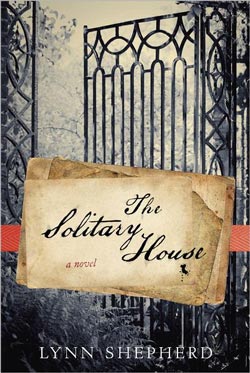
London, 1850. Charles Maddox had been an up-and-coming officer for the Metropolitan police until a charge of insubordination abruptly ended his career. Now he works alone, struggling to eke out a living by tracking down criminals
Charles has been approached by Edward Tulkinghorn, the shadowy and feared attorney, who offers him a handsome price to do some sleuthing for a client. Powerful financier Sir Julius Cremorne has been receiving threatening letters, and Tulkinghorn wants Charles to—discreetly—find and stop whoever is responsible.
But what starts as a simple, open-and-shut case swiftly escalates into something bigger and much darker.
The Solitary House (UK title: Tom-All-Alone’s) by Lynn Shepherd is an interesting literary take on London in 1850, and by “literary” I mean freely interacting with other fiction in a way that’s both an homage and a metatextual exploration. Aside from being a detective novel on its own, it includes events and characters from Charles Dickens’s novel Bleak House, as well as cameos by Dickens himself and by Wilkie Collins, author of The Moonstone, usually cited as the first detective novel in English. It’s a very different and much more elaborate novel than I was expecting.
Shepherd was known to me as the author of Murder at Mansfield Park (yes, the Jane Austen novel), which I have not yet read. I learned that the detective hero of The Solitary House, Charles Maddox, is the great-nephew of the detective hero of Murder at Mansfield Park, so the literary connections are present even between the author’s own two novels. I’d read in a review that the style of Murder was fairly close to Jane Austen’s style, so I assumed The Solitary House would read like Dickens. I was wrong!
Shepherd’s portrayal of 1850 London is much darker and more realistic than Dickens’s—to me, her London feels very modern in its, pardon my word choice, bleakness. Past and future are drawn together because the prose style has a contemporary feel, showcasing how our world today grew out of this one.
The story is told in present tense, with two different narrators. The reader is sometimes directly addressed: on those occasions, hints of a modern voice’s commentary on the world of 1850 come through.
. . . on this dark early-winter day in 1850 you might be forgiven for thinking you’ve been transported, on a sudden, to a circle of hell even the devil has given up for lost.
. . . From where we stand, the air is so deadened with a greasy yellow fog that you can barely see three paces ahead, and risk stumbling in the street over milk-cans, shattered bottles, and what look at first like rat-ridden heaps of rags, until they stare back at you with gin-hollowed eyes, and hold out their blackened hands for hard cash.
. . . He is a single man, this Charles Maddox, since the bed is narrow, the room small, and neither is very clean. He is careless of his appearance, to judge by the waistcoat hanging on the wardrobe door and the tangle of shirts spilling from the chest, but there are other things he does care about, for a large black cat has appropriated the best and warmest chair, which looks to have been placed next to the fire for precisely that purpose. He is a sentimental young man, then, but more than anything else he is a curious one. For by his possessions shall ye know him, and this room is a mirror of Charles Maddox’s mind.
. . . before you smile indulgently at the hopeless clutter, and dismiss him as a mere dilettante, remember that this is the age of the gifted amateur. Remember too, that in 1850 it is still possible—just—for an intelligent man to span the sciences and still attain a respectable proficiency in them all. If, of course, he has money enough, and time. If, in short, he is a gentleman. It is the right question to ask about Charles Maddox, but it does not come with an easy answer.
I think this novel would be most rewarding to readers already familiar with the plot and characters of Bleak House; but if you haven’t read that novel, or any Dickens at all, it is easily comprehensible, and it very well might pique your interest in the grim, crime-ridden world of mid-nineteenth century London.
Victoria Janssen is the author of three novels and numerous short stories. She has a World War One-set Spice Brief out in May titled “Under Her Uniform,” a tie-in to her novel The Moonlight Mistress. Follow her on Twitter: @victoriajanssen or find out more at victoriajanssen.com.
Read all of Victoria Janssen’s posts for Criminal Element.
See coverage of more new releases in our Fresh Meat series.

I got a hold of an ARC, and I really liked this book. The description and detail are great. I love Charles Maddox’s relationship with his famous detective uncle. I haven’t read any of her other novels and while I have read Bleak House, it’s been years. This is actually the best book I’ve picked up from a new author (to me) in a long time.
@DeborahLacy, I actually wouldn’t have minded even more of the uncle’s character.
@VictoriaJanssen – I totally agree with you on that. I enjoyed him even more than the protag, but I did enjoy Charles as well. This book turned out to be a really nice surprise.